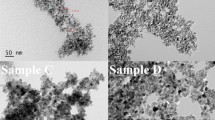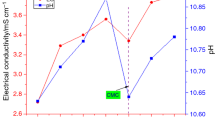Abstract
In the present work, we experimentally investigated the heat transfer mechanism of ZnO nanofluid in different organic solvents. The experimental results show that thermal diffusivity of organic solvents increase with the addition of ZnO nanoparticles. It was also found that the solvent-ZnO mixture is having more thermal diffusivity compared to solvent–water mixture.
Access provided by Autonomous University of Puebla. Download conference paper PDF
Similar content being viewed by others
1 Introduction
Nanofluids are new class of heat transfer fluid, which have immense applications in various fields such as microelectrionics, microfluids, MEMs etc. Nanofluids are the colloidal suspension of nanoparticles of the order of 1–100 nm in common base fluid such as water, ethylene glycol and silicon oil. Generally nanoparticles possess larger surface area compared to its bulk counterpart. This peculiarity of nanoparticles enhances the heat transferring properties of the nanofluid [1, 2]. Here we synthesize the ZnO based nanofluids using different organic solvents. A highly sensitive dual beam mode matched thermal lens technique was used to measure the thermal diffusivity of the prepared nanofluids.
2 Experimental
ZnO nanoparticles of size ~17 nm were synthesized using solution method. Zinc acetate dihydtrate and Sodium hydroxide were used as the precursors of the reaction. The heating temperature and time were 150 °C and 2 h respectively. Detailed description of synthesis method has been explained in previously published work [3]. Figure 193.1a Shows the TEM image of the spherically shaped ZnO nanoparticles. ZnO nanofluid was prepared by two-step method. ZnO nanoparticles with concentration 0.1 mg/ml dispersed in organic solvents such as methanol, ethanol, glycerol and ethylene glycol under ultrasonication of 1 h.
3 Results and Discussion
Thermal lens (TL) technique is a highly sensitive and nondistructive photothermal spectroscopy. It can measure very small changes in the refractive index due to the temperature variation in the medium. This refractive index change consequently produces a lensing effect. Thermal lens experimental setup and working principles were discussed in our previously published work [4]. The characteristics time constant tc is related with the thermal diffusivity (α) by the equation.
where ω is the beam waist radius. Firstly we estimated the thermal diffusivity of organic solvents used for the nanofluid preparation, as given in Table 193.1. These results are in agreement with the literature values. This indicates the accuracy of thermal lens technique. In the second steps, we measured the thermal diffusivity values of ZnO nanofluid prepared in different organic solvents and these values were compared with the diffusivity of solvent – water mixture with a volume ratio of 1:1. These results suggested that ZnO nanofluid shows an enhancement of thermal diffusivity with respect to the pure solvent as well as the solvent – water mixture as given in Table 193.1. The thermal diffusivity curve of ethanol-ZnO nanofluid is shown in Fig. 193.1b.
Nanoparticles when dispersed in liquids form nanolayers. Formation of this layered structure is expected to be the main reason for the enhancement of thermal property. This layered structure acts as a thermal bridge between bulk liquid and solvent nanoparticles [5]. Another reason is that the specific heat capacity of solid is lower than that of the base fluid. So the nanofluids possess lower specific heat capacity than that of the base fluid. The inverse relation between Thermal diffusivity (α) and the specific heat capacity (Cp) also contribute in the enhancement of thermal diffusivity of ZnO nanofluid [6].
4 Conclusion
Thermal lens technique offers a sensitive measurement of thermal diffusivity. Thermal diffusivity of the solvent was found to enhance with the incorporation of ZnO nanoparticles. So ZnO is a potential material for coolant applications.
References
A. Gupta, R. Kumar, Role of Brownian motion on the thermal conductivity enhancement of nanofluids Role of Brownian motion on the thermal conductivity enhancement. Appl. Phys. Lett. 223102, 2010–2013 (2011)
S.M.S. Murshed, C.A.N. De Castro, Superior thermal features of carbon nanotubes-based nano fl uids—a review. Renew. Sustain. Energy Rev. 37, 155–167 (2014)
M. Ramya, T.K. Nideep, K.R. Vijesh, V.P.N. Nampoori, M. Kailasnath, Synthesis of stable ZnO nanocolloids with enhanced optical limiting properties via simple solution method. Opt. Mater. (Amst) 81, 30–36 (2018)
K.R. Vijesh, U. Sony, M. Ramya, S. Mathew, V.P.N. Nampoori, S. Thomas, Concentration dependent variation of thermal di ff usivity in highly fl uorescent carbon dots using dual beam thermal lens technique. Int. J. Therm. Sci. 126, 137–142 (2018)
R. Herrera-aquino, Green synthesis of silver nanoparticles contained in centrifuged citrus oil and their thermal diffusivity. Int. J. Thermophys. 123, 1–10 (2019)
V.M. Lenart, N.G.C. Astrath, R.F. Turchiello, G.F. Goya, Thermal diffusivity of ferrofluids as a function of particle size determined using the mode-mismatched dual-beam thermal lens technique. J. Appl. Phys. 085107, 3–7 (2017)
Author information
Authors and Affiliations
Corresponding author
Editor information
Editors and Affiliations
Rights and permissions
Copyright information
© 2021 The Author(s), under exclusive license to Springer Nature Singapore Pte Ltd.
About this paper
Cite this paper
Ramya, M., Nideep, T., Varier, M.M., Nampoori, V., Kailasnath, M. (2021). Measurement of Thermal Diffusivity of Organic Solvents Based ZnO Nanofluids Using Thermal Lens Technique. In: Singh, K., Gupta, A.K., Khare, S., Dixit, N., Pant, K. (eds) ICOL-2019. Springer Proceedings in Physics, vol 258. Springer, Singapore. https://doi.org/10.1007/978-981-15-9259-1_193
Download citation
DOI: https://doi.org/10.1007/978-981-15-9259-1_193
Published:
Publisher Name: Springer, Singapore
Print ISBN: 978-981-15-9258-4
Online ISBN: 978-981-15-9259-1
eBook Packages: Physics and AstronomyPhysics and Astronomy (R0)





